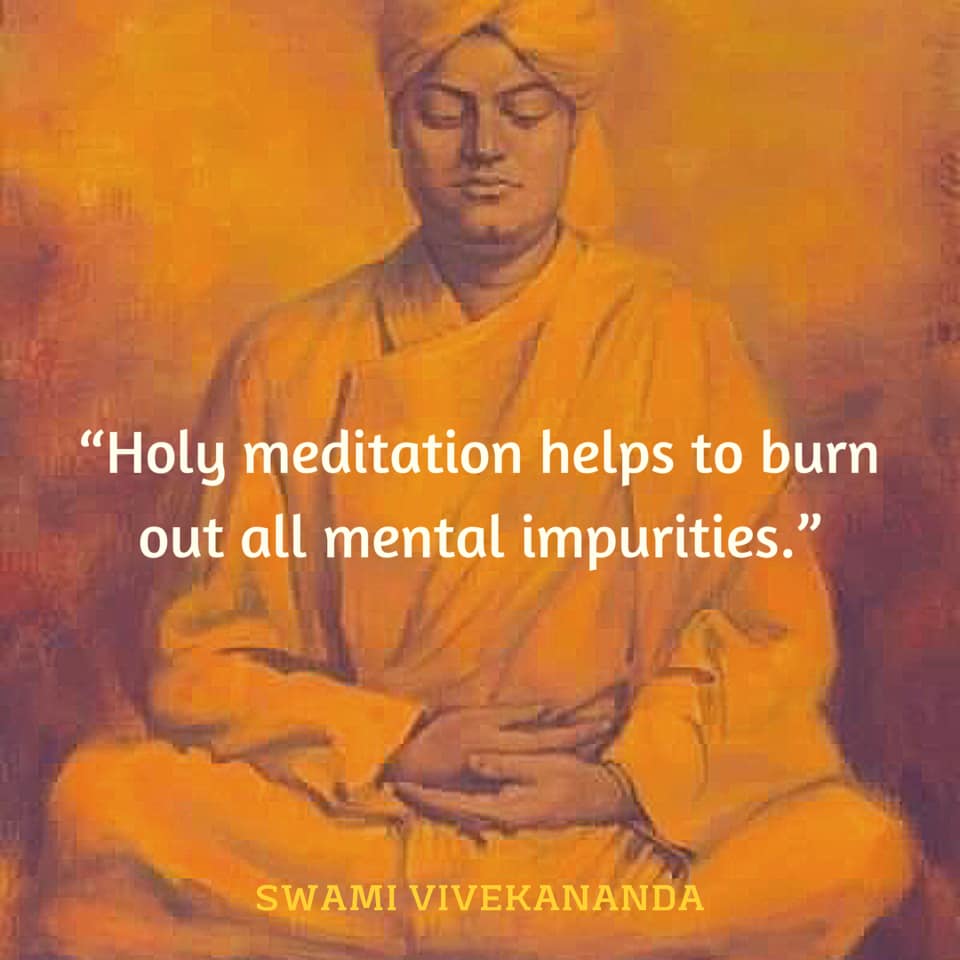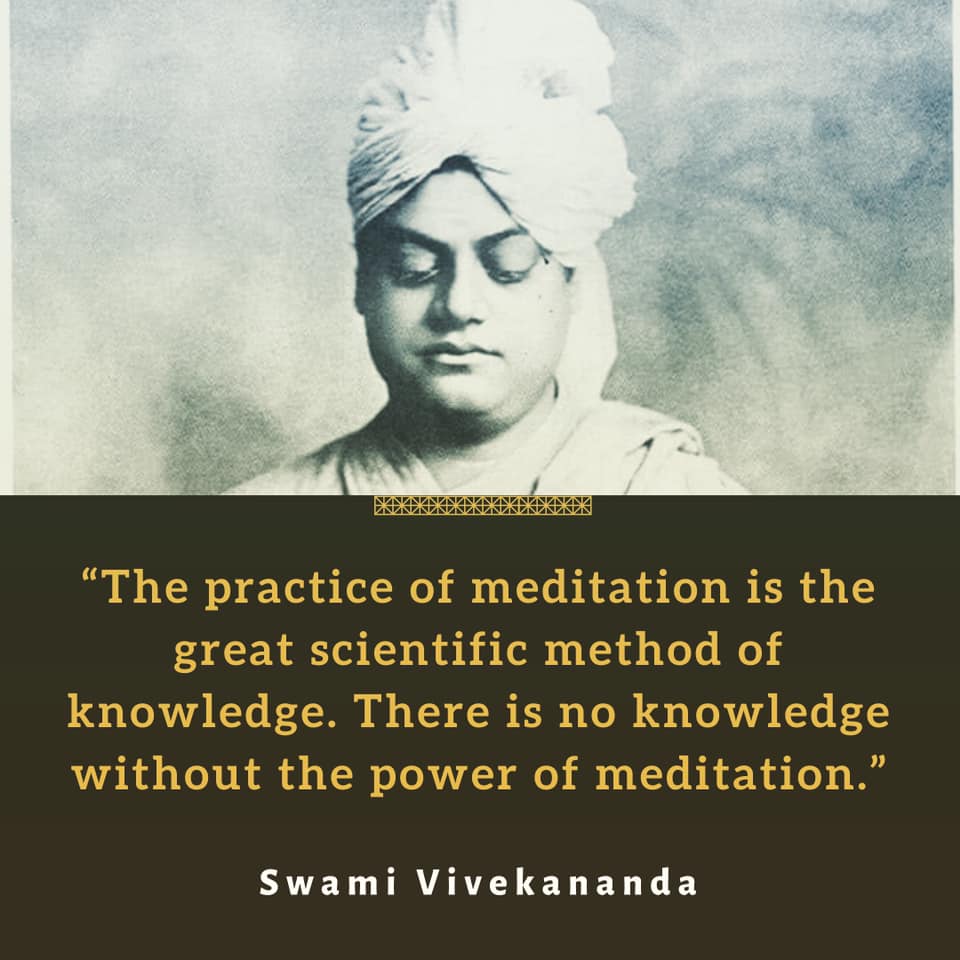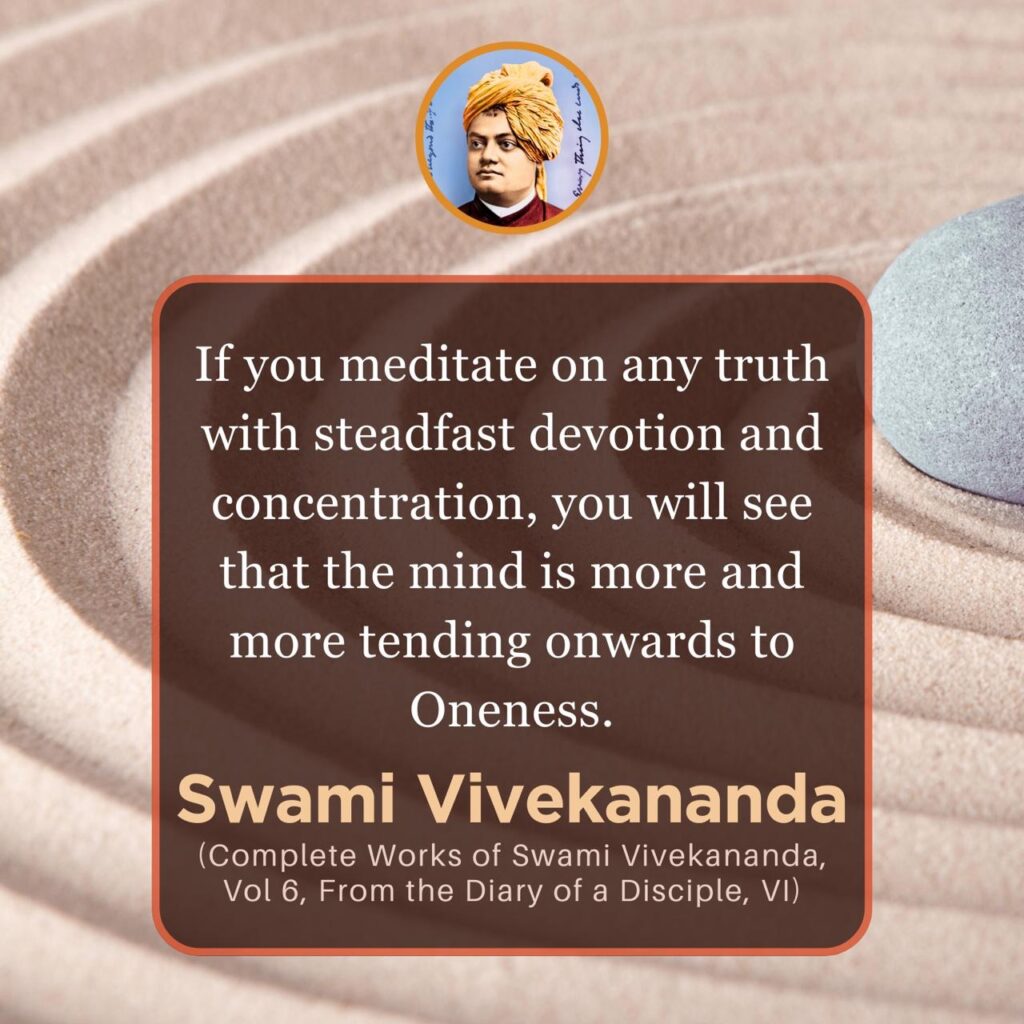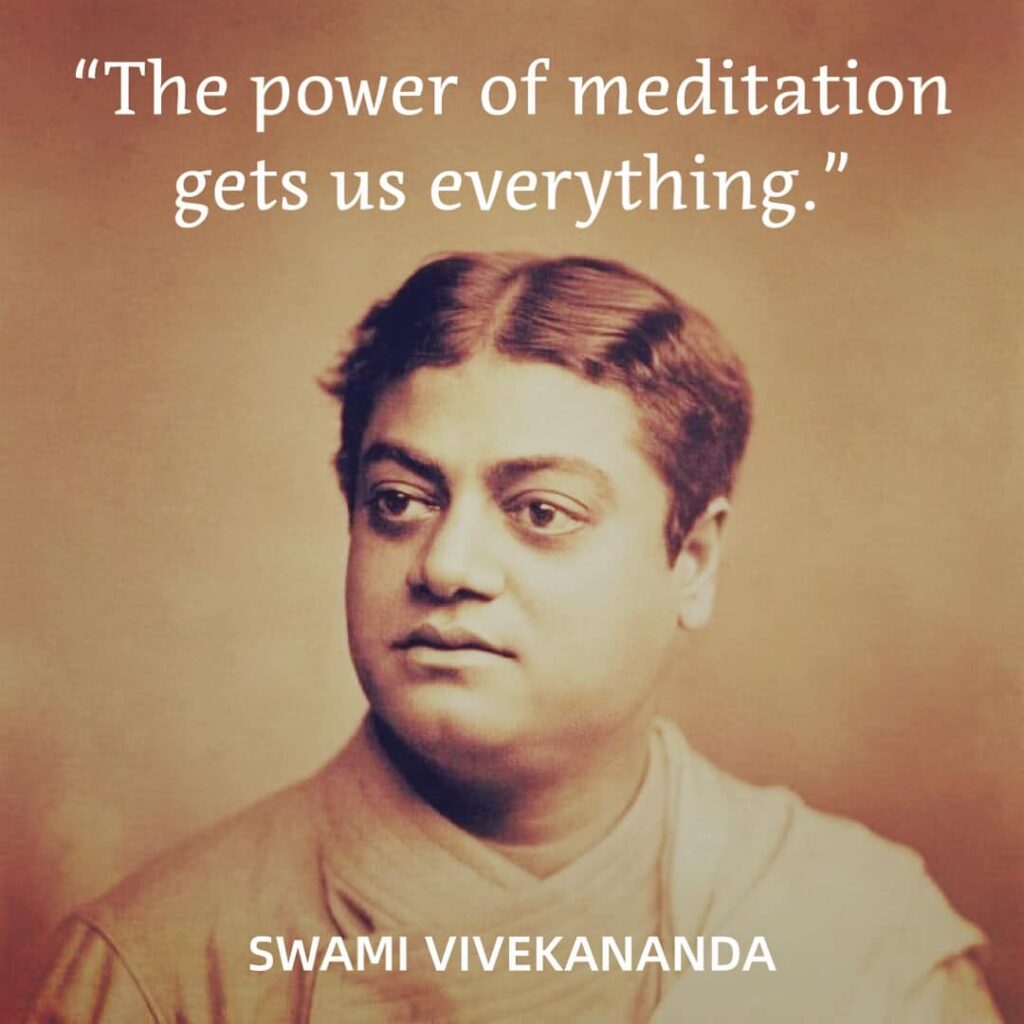
Swami Vivekananda‘s grip over meditation (dhyana) was visible from his early childhood. In his childhood he observed the elder members of his family worshipping and meditating. He too used to spend time in worshipping and meditating in front of idols of Hindu gods and goddesses such as Shiva, Rama, Krishna.
Ramakrishna found his disciple Narendranath (pre-monastic name of Vivekananda) a dhyana-siddha (expert in meditation). Narendra’s grip over meditation amazed Girish Chandra Ghosh, who recounted—[1]
One evening Narendra and I were meditating under a mango tree at the Cossipore garden house. I was about to enter into a deep concentration when the mosquitoes began to disturb me. I tried to slap them away, but the continued attacking me. I opened my eyes and found Narendra in a lotus posture. I did not want to leave the place without him. I called him but got no response; then I gently touched him, with no response either. I noticed his body was covered with mosquitoes like a blanket. I was amazed by his lack of body-consciousness, but frightened because he did not respond.
We have already seen Vivekananda had interest in meditation in his childhood. Actual he had the same interest for meditation throughout his life. He meditated for few hours on 4 July 1902 too, the day he died.
Vivekananda’s observation and suggestion was— “Meditation is the one thing. Meditate! The greatest thing is meditation. It is the nearest approach to spiritual life — the mind meditating. It is the one moment in our daily life that we are not at all material — the Soul thinking of Itself, free from all matter — this marvellous touch of the Soul!”[Source]
In this post we’ll make a collection of Swami Vivekananda‘s quotes, comments, and opinions on meditation (dhyana). Related articles are listed at the bottom of the page.
Introduction
Swami Vivekananda stressed on practising meditation as it brings one closer to another and increases the power of mind. He understood the prominent role of concentration of mind in the acquisition of wisdom. He said— “concentration is the essence of all knowledge”. He was responsible for introducing the Western world to meditation and Yoga.
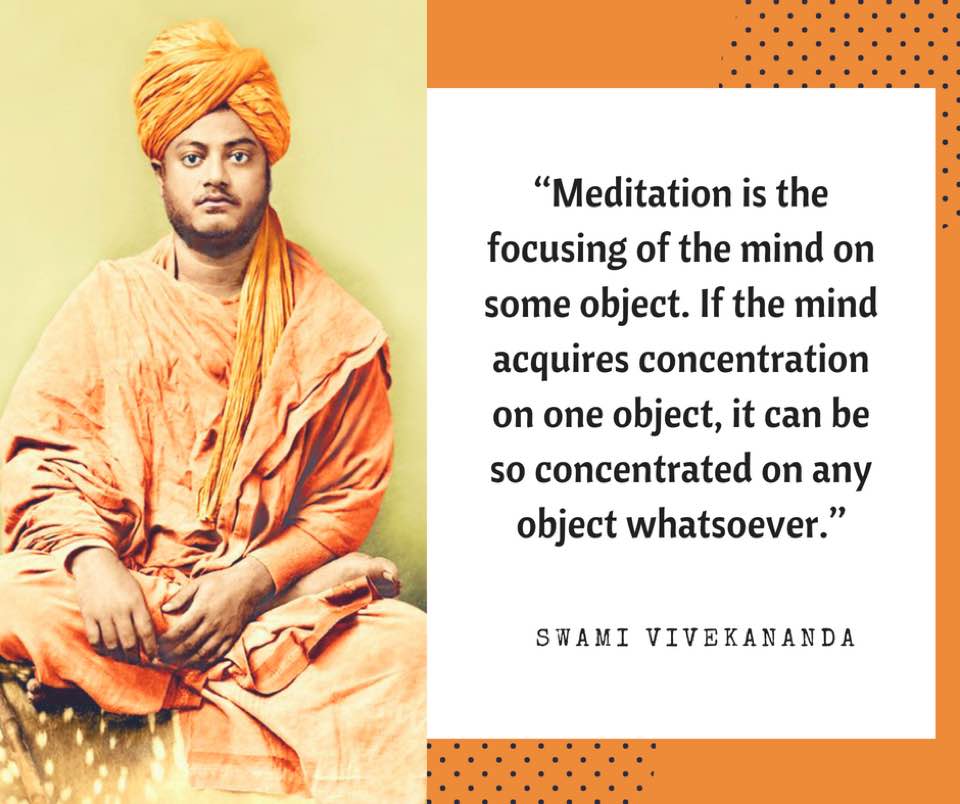
Swami Vivekananda’s quotes on meditation
- Day and night think and meditate on Brahman, meditate with great one-pointedness of mind. And during the time of awakeness to outward life, either do some work for the sake of others or repeat in your mind: “Let good happen to Jivas and the world!” “Let the mind of all flow in the direction of Brahman!” Even by such continuous current of thought the world will be benefited. Nothing good in the world becomes fruitless, be it work or thought.[Source]
- First, meditation should be of a negative nature. Think away everything. Analyse everything that comes in the mind by the sheer action of the will. Next, assert what we really are—existence, knowledge, and bliss—being, knowing, and loving.[Source]
- Holy meditation helps to burn out all mental impurities.[Source](See also Bhagavad Gita 6.12)
- “I do not want to get material life, do not want the sense-life, but something higher.” That is renunciation. Then, by the power of meditation, undo the mischief that has been done.
- If you meditate on any truth with steadfast devotion and concentration, you will see that the mind is more and more tending onwards to Oneness, i.e. taking you towards the realisation of the absolute Existence-Knowledge-Bliss.[Source]
- In real meditation you forget the body. You may be cut to pieces and not feel it at all. You feel such pleasure in it. You become so light. This perfect rest we will get in meditation.
- Just as I sit down to meditate, all the vilest subjects in the world come up. The whole thing is nauseating. Why should the mind think thoughts I do not want it to think? I am as it were a slave to the mind. [Source]
- Meditation is a sort of prayer and prayer is meditation. The highest meditation is to think of nothing. If you can remain one moment without thought, great power will come.[Source]
- Meditation is the means of unification of the subject and object. Meditate.[Source]
- Meditation means the mind is turned back upon itself. The mind stops all the thought-waves and the world stops. Your consciousness expands. Every time you meditate you will keep your growth.
- Meditation, you know, comes by a process imagination. You go through all these processes purification of the elements — making the one melt the other, that into the next higher, that into mind, that into spirit, and then you are spirit.[Source]
- Meditative state is the highest state of existence. So long as there is desire, no real happiness can come. It is only the contemplative, witness-like study of objects that brings to us real enjoyment and happiness. The animal has its happiness in the senses, the man in his intellect, and the god in spiritual contemplation. It is only to the soul that has attained to this contemplative state that the world really becomes beautiful. To him who desires nothing, and does not mix himself up with them, the manifold changes of nature are one panorama of beauty and sublimity.
- Not even the deepest sleep will give you such a rest as meditation can. The mind goes on jumping even in deepest sleep. Just those few moments in meditation your brain has almost stopped. … You forget the body. … You feel such pleasure in it. You become so light. This perfect rest we will get in meditation.
- Om is the pointed piece and Dhyâna (meditation) is the friction.[Source]
- Self-realisation is to be attained by renunciation, by meditation—renunciation of all the senses, cutting the knots, the chains that bind us down to matter.
- The meditative state is the highest state of existence. So long as there is desire, no real happiness can come. It is only the contemplative, witness-like study of objects that brings to us real enjoyment and happiness.
- The power of meditation gets us everything. If you want to get power over nature, [you can have it through meditation]. It is through the power of meditation all scientific facts are discovered today. They study the subject and forget everything, their own identity and everything, and then the great fact comes like a flash. Some people think that is inspiration. There is no more inspiration than there is expiration; and never was anything got for nothing.[Source]
- Thought ceases in meditation; even the mind’s elements are quite quiet. Blood circulation stops. His breath stops, but he is not dead.[Source]
- To realise the spirit as spirit is practical religion. Everything else is good so far as it leads to this one grand idea. That realisation is to be attained by renunciation, by meditation—renunciation of all the senses, cutting the knots, the chains that bind us down to matter.
- Try a little harder, and meditation comes. You do not feel the body or anything else. When you come out of it after the hour, you have had the most beautiful rest you ever had in your life. That is the only way you ever give rest to your system. Not even the deepest sleep will give you such a rest as that.
- Whose meditation is real and effective? Who can really surrender to the will of God? Only the person whose mind has been purified by selfless work.
- Work a little harder at meditation and it comes. You do not feel the body or anything else. When you come out of it after the hour, you have had the most beautiful rest you ever had in your life. That is the only way you ever give rest to your system.
Controlling the mind
From Swami Vivekananda’s Raja Yoga, Chapter: Pratyahara And Dharana—[Source]How hard it is to control the mind! Well has it been compared to the maddened monkey. There was a monkey, restless by his own nature, as all monkeys are. As if that were not enough some one made him drink freely of wine, so that he became still more restless. Then a scorpion stung him. When a man is stung by a scorpion, he jumps about for a whole day; so the poor monkey found his condition worse than ever. To complete his misery a demon entered into him. What language can describe the uncontrollable restlessness of that monkey? The human mind is like that monkey, incessantly active by its own nature; then it becomes drunk with the wine of desire, thus increasing its turbulence. After desire takes possession comes the sting of the scorpion of jealousy at the success of others, and last of all the demon of pride enters the mind, making it think itself of all importance. How hard to control such a mind!
What is meditation?
In a lecture delivered at Alameda, California, on 18 April, 1900, Vivekananda told—
What is meditation? Meditation is the power which enables us to resist all this. Nature may call us, “Look there is a beautiful thing!” I do not look. Now she says, “There is a beautiful smell; smell it! ” I say to my nose, “Do not smell it”, and the nose doesn’t. “Eyes, do not see!” Nature does such an awful thing – kills one of my children, and says, “Now, rascal, sit down and weep! Go to the depths!” I say, “I don’t have to.” I jump up. I must be free. Try it sometimes. … [In meditation], for a moment, you can change this nature. Now, if you had that power in yourself, would not that be heaven, freedom? That is the power of meditation.[Source]
While discussing Dhyana and Samadhi (Raja Yoga) Vivekananda told—
“When the mind has been trained to remain fixed on a certain internal or external location, there comes to it the power of flowing in an unbroken current, as it were, towards that point. This state is called Dhyana.
These ideas have to be understood in Dhyana, or meditation. We hear a sound. First, there is the external vibration; second, the nerve motion that carries it to the mind; third, the reaction from the mind, along with which flashes the knowledge of the object which was the external cause of these different changes from the ethereal vibrations to the mental reactions. These three are called in Yoga, Shabda (sound), Artha (meaning), and Jnâna (knowledge). In the language of physics and physiology they are called the ethereal vibration, the motion in the nerve and brain, and the mental reaction. Now these, though distinct processes, have become mixed up in such a fashion as to become quite indistinct. In fact, we cannot now perceive any of these, we only perceive their combined effect, what we call the external object. Every act of perception includes these three, and there is no reason why we should not be able to distinguish them.”[Source]
When, by the previous preparations, it becomes strong and controlled, and has the power of finer perception, the mind should be employed in meditation. This meditation must begin with gross objects and slowly rise to finer and finer, until it becomes objectless. The mind should first be employed in perceiving the external causes of sensations, then the internal motions, and then its own reaction. When it has succeeded in perceiving the external causes of sensations by themselves, the mind will acquire the power of perceiving all fine material existences, all fine bodies and forms. When it can succeed in perceiving the motions inside by themselves, it will gain the control of all mental waves, in itself or in others, even before they have translated themselves into physical energy; and when he will be able to perceive the mental reaction by itself, the Yogi will acquire the knowledge of everything, as every sensible object, and every thought is the result of this reaction. Then will he have seen the very foundations of his mind, and it will be under his perfect control.[Source]
Meditation is a science
From Swami Vivekananda’s lecture Meditation, delivered at the Washington Hall, San Francisco, April 3, 1900—[Source]
Whatever exists is one. There cannot be many. That is what is meant by science and knowledge. Ignorance sees manifold. Knowledge realises one. … Reducing the many into one is science. … The whole of the universe has been demonstrated into one. That science is called the science of Vedanta. The whole universe is one. The one runs through all this seeming variety. …
We have all these variations now and we see them — what we call the five elements: solid, liquid, gaseous, luminous, ethereal. After that the state of existence is mental and beyond that spiritual. Not that spirit is one and mind is another, ether another, and so on. It is the one existence appearing in all these variations. To go back, the solid must become liquid. The way [the elements evolved] they must go back. The solids will become liquid, etherised. This is the idea of the macrocosm — and universal. There is the external universe and universal spirit, mind, ether, gas, luminosity, liquid, solid.
The same with the mind. I am just exactly the same in the microcosm. I am the spirit; I am mind; I am the ether, solid, liquid, gas. What I want to do is to go back to my spiritual state. It is for the individual to live the life of the universe in one short life. Thus man can be free in this life. He in his own short lifetime shall have the power to live the whole extent of life….
We all struggle. . . . If we cannot reach the Absolute, we will get somewhere, and it will be better than we are now.
Meditation consists in this practice [of dissolving every thing into the ultimate Reality — spirit]. The solid melts into liquid, that into gas, gas into ether, then mind, and mind will melt away. All is spirit.
Some of the Yogis claim that this body will become liquid etc. You will be able to do any thing with it — make it little, or gas pass through this wall — they claim. I do not know. I have never seen anybody do it. But it is in the books. We have no reason to disbelieve the books.
Possibly, some of us will be able to do it in this life. Like a flash it comes, as the result of our past work. Who knows but some here are old Yogis with just a little to do to finish the whole work. Practice!
Meditation, you know, comes by a process imagination. You go through all these processes purification of the elements — making the one melt the other, that into the next higher, that into mind, that into spirit, and then you are spirit.
Environment for meditation
From Swami Vivekananda’s book Raja Yoga, Chapter: The First Steps—[Source]
Those of you who can afford it will do better to have a room for this practice alone. Do not sleep in that room, it must be kept holy. You must not enter the room until you have bathed, and are perfectly clean in body and mind. Place flowers in that room always; they are the best surroundings for a Yogi; also pictures that are pleasing. Burn incense morning and evening. Have no quarrelling, nor anger, nor unholy thought in that room. Only allow those persons to enter it who are of the same thought as you. Then gradually there will be an atmosphere of holiness in the room, so that when you are miserable, sorrowful, doubtful, or your mind is disturbed, the very fact of entering that room will make you calm. This was the idea of the temple and the church, and in some temples and churches you will find it even now, but in the majority of them the very idea has been lost. The idea is that by keeping holy vibrations there the place becomes and remains illumined. Those who cannot afford to have a room set apart can practice anywhere they like.
How to meditate?
Vivekananda taught “how to meditate” too. In a lecture delivered at San Francisco on 5 April 1900, he told—
First, to sit in the posture In which you can sit still for a long time. All the nerve currents which are working pass along the spine. The spine is not intended to support the weight of the body. Therefore the posture must be such that the weight of the body is not on the spine. Let it be free from all pressure.[Source]
From Swami Vivekananda’s book Raja Yoga, Chapter: The First Steps—[Source]
Sit in a straight posture, and the first thing to do is to send a current of holy thought to all creation. Mentally repeat, “Let all beings be happy; let all beings be peaceful; let all beings be blissful.” So do to the east, south, north and west. The more you do that the better you will feel yourself. You will find at last that the easiest way to make ourselves healthy is to see that others are healthy, and the easiest way to make ourselves happy is to see that others are happy. After doing that, those who believe in God should pray — not for money, not for health, nor for heaven; pray for knowledge and light; every other prayer is selfish. Then the next thing to do is to think of your own body, and see that it is strong and healthy; it is the best instrument you have. Think of it as being as strong as adamant, and that with the help of this body you will cross the ocean of life. Freedom is never to be reached by the weak. Throw away all weakness. Tell your body that it is strong, tell your mind that it is strong, and have unbounded faith and hope in yourself.
In the book Raja Yoga, he wrote—
Dhyana (Meditation) is spoken of, and a few examples are given of what to meditate upon. Sit straight, and look at the tip of your nose. Later on we shall come to know how that concentrates the mind, how by controlling the two optic nerves one advances a long way towards the control of the arc of reaction, and so to the control of the will. Here are a few specimens of meditation. Imagine a lotus upon the top of the head, several inches up, with virtue as its centre, and knowledge as its stalk. The eight petals of the lotus are the eight powers of the Yogi. Inside, the stamens and pistils are renunciation. If the Yogi refuses the external powers he will come to salvation. So the eight petals of the lotus are the eight powers, but the internal stamens and pistils are extreme renunciation, the renunciation of all these powers. Inside of that lotus think of the Golden One, the Almighty, the Intangible, He whose name is Om, the Inexpressible, surrounded with effulgent light. Meditate on that. Another meditation is given. Think of a space in your heart, and in the midst of that space think that a flame is burning. Think of that flame as your own soul and inside the flame is another effulgent light, and that is the Soul of your soul, God. Meditate upon that in the heart. Chastity, non-injury, forgiving even the greatest enemy, truth, faith in the Lord, these are all different Vrittis. Be not afraid if you are not perfect in all of these; work, they will come. He who has given up all attachment, all fear, and all anger, he whose whole soul has gone unto the Lord, he who has taken refuge in the Lord, whose heart has become purified, with whatsoever desire he comes to the Lord, He will grant that to him. Therefore worship Him through knowledge, love, or renunciation.[Source]
In the Alameda lecture (details above), Vivekananda suggested one should train (her/him)self slowly gradually. One needs to practise meditation on a regular basis.[Source]
How is it to be attained? In a dozen different ways. Each temperament has its own way. But this is the general principle: get hold of the mind. The mind is like a lake, and every stone that drops into it raises waves. These waves do not let us see what we are. The full moon is reflected in the water of the lake, but the surface is so disturbed that we do not see the reflection clearly. Let it be calm. Do not let nature raise the wave. Keep quiet, and then after a little while she will give you up. Then we know what we are. God is there already, but the mind is so agitated, always running after the senses. You close the senses and [yet] you whirl and whirl about. Just this moment I think I am all right and I will meditate upon God, and then my mind goes to London in one minute. And if I pull it away from there, it goes to New York to think about the things I have done there in the past. These [waves] are to be stopped by the power of meditation.
Slowly and gradually we are to train ourselves. It is no joke — not a question of a day, or years, or maybe of births. Never mind! The pull must go on. Knowingly, voluntarily, the pull must go on. Inch by inch we will gain ground. We will begin to feel and get real possessions, which no one can take away from us — the wealth that no man can take, the wealth that nobody can destroy, the joy that no misery can hurt any more. …
Stages of meditation
From Swami Vivekananda’s lecture Meditation—[Source]
There are three stages in meditation. The first is what is called [Dharana], concentrating the mind upon an object. I try to concentrate my mind upon this glass, excluding every other object from my mind except this glass. But the mind is wavering . . . When it has become strong and does not waver so much, it is called [Dhyana], meditation. And then there is a still higher state when the differentiation between the glass and myself is lost — [Samadhi or absorption]. The mind and the glass are identical. I do not see any difference. All the senses stop and all powers that have been working through other channels of other senses [are focused in the mind]. Then this glass is under the power of the mind entirely. This is to be realised. It is a tremendous play played by the Yogis.
Meditation — the greatest help to spiritual life
From a lecture of Swamiji delivered at the Home of Truth, Los Angeles, California—[Source]
The greatest help to spiritual life is meditation (Dhyâna). In meditation we divest ourselves of all material conditions and feel our divine nature. We do not depend upon any external help in meditation. The touch of the soul can paint the brightest colour even in the dingiest places; it can cast a fragrance over the vilest thing; it can make the wicked divine — and all enmity, all selfishness is effaced. The less the thought of the body, the better. For it is the body that drags us down. It is attachment, identification, which makes us miserable. That is the secret: To think that I am the spirit and not the body, and that the whole of this universe with all its relations, with all its good and all its evil, is but as a series of paintings — scenes on a canvas — of which I am the witness.
Meditation and emotions
From Complete Works, Volume VII, Conversations and dialogues—[Source]
Meditate every day alone. Everything will open up of itself. Now the Divine Mother — the embodiment of illumination — is sleeping within, hence you do not understand this. She is the Kundalini. When, before meditating, you proceed to “purify the nerves”, you must mentally strike hard on the Kundalini in the Muladhara (sacral plexus), and repeat, “Arise, Mother, arise!” One must practise these slowly. During meditation, suppress the emotional side altogether. This is a great source of danger. Those that are very emotional no doubt have their Kundalini rushing quickly upwards, but it is as quick to come down as to go up. And when it does come down, it leaves the devotee in a state of utter ruin. It is for this reason that Kirtanas and other auxiliaries to emotional development have a great drawback. It is true that by dancing and jumping, etc. through a momentary impulse, that power is made to course upwards, but it is never enduring. On the contrary when it traces back its course, it rouses violent lust in the individual. Listening to my lectures in America, through temporary excitement many among the audience used to get into an ecstatic state, and some would even become motionless like statues. But on inquiry I afterwards found that many of them had an excess of the carnal instinct immediately after that state. But this happens simply owing to a lack of steady practice in meditation and concentration.

You yourself will be the object of your meditation
From Complete Works Volume VII—[Source]
You yourself will be the object of your meditation. Think and meditate that you are the omnipresent Atman. “I am neither the body, nor the mind, nor the Buddhi (determinative faculty), neither the gross nor the subtle body”– by this process of elimination, immerse your mind in the transcendent knowledge which is your real nature. Kill the mind by thus plunging it repeatedly in this. Then only you will realise the Essence of Intelligence, or be established in your real nature. Knower and known, meditator and the object meditated upon will then become one, and the cessation of all phenomenal superimpositions will follow. This is styled in the Shastras as the transcendence of the triad or relative knowledge (Triputibheda). There is no relative or conditioned knowledge in this state. When the Atman is the only knower, by what means can you possibly know It? The Atman is Knowledge, the Atman is Intelligence, the Atman is Sachchidananda. It is through the inscrutable power of Maya, which cannot be indicated as either existent or non – existent, that the relative consciousness has come upon the Jiva who is none other than Brahman. This is generally known as the conscious state. And the state in which this duality of relative existence becomes one in the pure Brahman is called in the scriptures the superconscious state and described in such words as, “[(Sanskrit)]– it is like an ocean perfectly at rest and without a name” (Vivekachudamani, 410).
Meditation is the gate of infinite joy
Meditation is the gate that opens that (infinite joy) to us. Prayers, ceremonials, and all the other forms of worship are simply kindergartens of meditation. You pray, you offer something. A certain theory existed that everything raised one’s spiritual power. The use of certain words, flowers, images, temples, ceremonials like the waving of lights brings the mind to that attitude, but that attitude is always in the human soul, nowhere else. [People] are all doing it; but what they do without knowing it, do knowingly. That is the power of meditation. All knowledge you have — how did it come? From the power of meditation. The soul churned the knowledge out of its own depths. What knowledge was there ever outside of it? In the long run this power of meditation separates ourselves from the body, and then the soul knows itself as it is — the unborn, the deathless, and birthless being. No more is there any misery, no more births upon this earth, no more evolution. [The soul knows itself as having] ever been perfect and free.[Source]
See also
References
- Book: Swami Vivekananda New Perspectives; Chapter: Meditation: Its Influence on the Mind of the Future; Author: Sandarshanananda, Swami; Pages: 655—656 ISBN: 978-93-81325-23-0
External links
- Dhyana and Samadhi from The Complete Works of Swami Vivekananda Volume I
- Meditation from The Complete Works of Swami Vivekananda Volume IV
